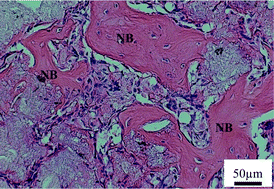3D-printing of highly uniform CaSiO3 ceramic scaffolds: preparation, characterization and in vivo osteogenesis
Abstract

* Corresponding authors
a
State Key Laboratory of High Performance Ceramics and Superfine Microstructure, Shanghai Institute of Ceramics, Chinese Academy of Sciences, Shanghai 200050, People's Republic of China
E-mail:
chengtiewu@mail.sic.ac.cn
Fax: +86-21-52412806
Tel: +86-21-52412806
b
Institute of Health & Biomedical Innovation, Queensland University of Technology, Brisbane, Queensland 4059, Australia
E-mail:
yin.xiao@qut.edu.au
Fax: +61-7-31386099
Tel: +61-7-31386240
c Centre for Translational Bone, Joint and Soft Tissue Research, Medical Faculty and Hospital, Dresden University of Technology, D-01307 Dresden, Germany

 Please wait while we load your content...
Something went wrong. Try again?
Please wait while we load your content...
Something went wrong. Try again?
C. Wu, W. Fan, Y. Zhou, Y. Luo, M. Gelinsky, J. Chang and Y. Xiao, J. Mater. Chem., 2012, 22, 12288 DOI: 10.1039/C2JM30566F
To request permission to reproduce material from this article, please go to the Copyright Clearance Center request page.
If you are an author contributing to an RSC publication, you do not need to request permission provided correct acknowledgement is given.
If you are the author of this article, you do not need to request permission to reproduce figures and diagrams provided correct acknowledgement is given. If you want to reproduce the whole article in a third-party publication (excluding your thesis/dissertation for which permission is not required) please go to the Copyright Clearance Center request page.
Read more about how to correctly acknowledge RSC content.
 Fetching data from CrossRef.
Fetching data from CrossRef.
This may take some time to load.
Loading related content
